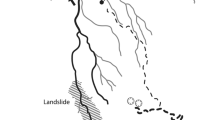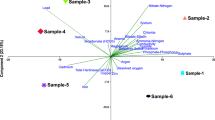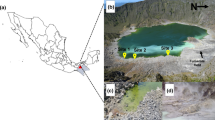Abstract
Aquatic environments of volcanic origin provide an exceptional opportunity to study the adaptations of microorganisms to early planet life conditions. Here, we characterized the prokaryotic communities and physicochemical properties of seepage sites at the bottom of the Poas Volcano crater and the Agrio River, two geologically related extremely acidic environments located in Costa Rica. Both locations hold a low pH (1.79–2.20) and have high sulfate and iron concentrations (Fe = 47–206 mg/L, SO42− = 1170–2460 mg/L), but significant differences in their temperature (90.0–95.0 ºC in the seepages at Poas Volcano, 19.1–26.6 ºC in Agrio River) and in the elemental sulfur content. Based on the analysis of 16S rRNA gene sequences, we determined that Sulfobacillus spp. represented more than half of the sequences in Poas Volcano seepage sites, while Agrio River was dominated by Leptospirillum and members of the archaeal order Thermoplasmatales. Both environments share some chemical characteristics and part of their microbiota, however, the temperature and the reduced sulfur are likely the main distinguishing features, ultimately shaping their microbial communities. Our data suggest that in the Poas Volcano–Agrio River system there is a common metabolism but with specialization of species that adapt to the physicochemical conditions of each environment.

taken from Google Earth Pro 7.7.3.7699. 2020. Poas Volcano and surrounds 10°11′53.16″ N,84°13′49.66"W, elevation 2340 M. 2D map, viewed 20 February 2020. http://www.google.com/earth/index.html. c Poas Volcano was in a period of high instability during the sampling campaign, the figure shows a significant amount of gases and that the lake was almost completely dry. d Agrio River is an ARD-like habitat which shows a yellow color in sediments. The waters looked completely colorless and with little material in suspension


source RA1. Same color code applies for the pH and temperature data. Included are Isosol lines corresponding to dissolution of 1 g and 10 g whole rock per liter of water



Similar content being viewed by others
References
Amils R, Fernández-Remolar D, The IPBSL Team (2014) Río tinto: a geochemical and mineralogical terrestrial analogue of Mars. Life 4:511–534. https://doi.org/10.3390/life4030511
Arce-Rodríguez A, Puente-Sánchez F, Avendaño R, Libby E, Rojas L, Cambronero JC, Pieper DH, Timmis KN, Chavarría M (2017) Pristine but metal-rich Río Sucio (Dirty River) is dominated by Gallionella and other iron-sulfur oxidizing microbes. Extremophiles 21:235–243. https://doi.org/10.1007/s00792-016-0898-7
Arce-Rodríguez A, Puente-Sánchez F, Avendaño R, Martínez-Cruz M, Maarten de Moor J, Pieper DH, Chavarría M (2019) Thermoplasmatales and sulfur-oxidizing bacteria dominate the microbial community at the surface water of a CO2-rich hydrothermal spring located in Tenorio Volcano National Park, Costa Rica. Extremophiles 23:177–187. https://doi.org/10.1007/s00792-018-01072-6
Arce-Rodríguez A, Puente-Sánchez F, Avendaño R, Libby E, Mora-Amador R, Rojas-Jimenez K, Martínez M, Pieper DH, Chavarría M (2020) Microbial community structure along a horizontal oxygen gradient in a Costa Rican volcanic influenced acid rock drainage system. Microb Ecol. https://doi.org/10.1007/s00248-020-01530-9
Bohorquez LC, Delgado-Serrano L, López G, Osorio-Forero C, Klepac-Ceraj V, Kolter R, Junca H, Baena S, Zambrano MM (2012) In-depth characterization via complementing culture-independent approaches of the microbial community in an acidic hot spring of the Colombian Andes. Microb Ecol 63:103–111. https://doi.org/10.1007/s00248-011-9943-3
Bradl HB (2005) Sources and origins of heavy metals. In: Bradl HB (eds) Heavy metals in the environment: origin, interaction and remediation, Interface Science and Technology, Elsevier 6:1-27. https://doi.org/10.1016/S1573-4285(05)80020-1
Castellón E, Martínez M, Madrigal-Carballo S, Arias ML, Vargas WE, Chavarría M (2013) Scattering of light by colloidal aluminosilicate particles produces the unusual sky-blue color of Río Celeste (Tenorio volcano complex, Costa Rica). PLoS ONE 8:e75165. https://doi.org/10.1371/journal.pone.0075165
Chiacchiarini P, Lavalle L, Giaveno A, Donati E (2010) First assessment of acidophilic microorganisms from geothermal Copahue-Caviahue system. Hydrometallurgy 104:334–341. https://doi.org/10.1016/j.hydromet.2010.02.020
Cigolini C, Kudo AM, Brookins DG, Ward D (1991) The petrology of Poas Volcano lavas: basalt-andesite relationship and their petrogenesis within the magmatic arc of Costa Rica. J Volcanol and Geotherm Res 48:367–384. https://doi.org/10.1016/0377-0273(91)90052-2
Cole JR, Wang Q, Fish JA, Chai B, McGarrell DM, Sun Y, Brown T, Porras-Alfaro A, Kuske CR, Tiedje JM (2014) Ribosomal database project: data and tools for high throughput rRNA analysis. Nucleic Acids Res 42:633–642. https://doi.org/10.1093/nar/gkt1244
Core Team R (2017) R: a language and environment for statistical computing. R foundation for statistical computing, Vienna, Austria http://www.R-project.org/. Accessed 29 April 2020
Daims H (2014) The family Nitrospiraceae. In: Rosenberg E, DeLong EF, Lory S et al (eds) The prokaryotes. Springer, Berlin, Heidelberg https://doi.org/10.1007/978-3-642-38954-2_126
Danovaro R, Canals M, Tangherlini M, Danovaro R, Canals M, Tangherlini M, Dell’Anno A, Gambi C, Lastras G, Amblas D, Sanchez-Vidal A, Frigola J, Calafat AM, Pedrosa-Pàmies R, Rivera J, Rayo X, Corinaldesi C (2017) A submarine volcanic eruption leads to a novel microbial habitat. Nat Ecol Evol 1:0144. https://doi.org/10.1038/s41559-017-0144
Delmelle P, Bernard A (2015) The remarkable chemistry of sulfur in hyper-acid crater lakes: a scientific tribute to Bokuichiro Takano and Minoru Kusakabe. In: Rouwet D , Christenson B , Tassi F, Vandemeulebrouck J (eds) Volcanic lakes. Advances in Volcanology. Springer, Berlin, Heidelberg
Doelsch E, Macary HS, Van de Kerchove V (2006) Sources of very high heavy metal content in soils of volcanic island (La Réunion). J Geochem Explor 88:1–3. https://doi.org/10.1016/j.gexplo.2005.08.037
Dongarrà G, Varrica D (1998) The presence of heavy metals in air particulate at Vulcano island. Sci Total Environ 212:1–9. https://doi.org/10.1016/S0048-9697(97)00323-9
Dopson M, Holmes DS (2014) Metal resistance in acidophilic microorganisms and its significance for biotechnologies. Appl Microbiol Biotechnol 98:8133–8144. https://doi.org/10.1007/s00253-014-5982-2
Dopson M, Johnson DB (2012) Biodiversity, metabolism and applications of acidophilic sulfur-metabolizing microorganisms. Environ Microbiol 14:2620–2631. https://doi.org/10.1111/j.1462-2920.2012.02749.x
Eng A, Borenstein E (2018) Taxa-function robustness in microbial communities. Microbiome 6:e45. https://doi.org/10.1186/s40168-018-0425-4
Fujimura R, Sato Y, Nishizawa T, Nanba K, Oshima K, Hattori M, Kamijo T, Ohta H (2012) Analysis of early bacterial communities on volcanic deposits on the island of Miyake (Miyake-jima), Japan: a 6-year study at a fixed site. Microbes Environ 27:19–29. https://doi.org/10.1264/jsme2.me11207
Fullerton KM, Schreck M, Yucel M,Manini E, Basili M, Rogers TJ, Fattorini D, Di Carlo M, d’Errico GU, Regoli F, Nakagawa M, Vetriani C, Smedile F, Ramírez C, Miller H, Morrison SM Buongiorno J, Jessen GL, Steen AD, Martínez M, Maarten de Moor J, Barry PH, Giovannelli D, Lloyd KG (2020) Tectonic processes shape biosphere-geosphere feedbacks across a convergent margin. EarhArXiv preprints. https://eartharxiv.org/gyr7n/. Accessed 12 July 2020
Golyshina OV, Lünsdorf H, Kublanov IV, Goldenstein NI, Hinrichs KU, Golyshin PN (2016) The novel extremely acidophilic, cell-wall-deficient archaeon Cuniculiplasma divulgatum gen. nov., sp. nov. represents a new family, Cuniculiplasmataceae fam. nov., of the order Thermoplasmatales. Int J Syst Evol Microbiol 66:332–340. https://doi.org/10.1099/ijsem.0.000725
Gómez F, Cavalazzi B, Rodríguez N, Amils R, Ori GG, Olsson-Francis K, Escudero C, Martínez JM, Miruts H (2019) Ultra-small microorganisms in the polyextreme conditions of the Dallol volcano, Northern Afar. Ethiopia Sci Rep 9:e7907. https://doi.org/10.1038/s41598-019-44440-8
Guo X, Yin H, Liang Y, Hu Q, Zhou X, Xiao Y, Ma L, Zhang X, Qiu G, Liu X (2014) Comparative genome analysis reveals metabolic versatility and environmental adaptations of Sulfobacillus thermosulfidooxidans strain ST. PLoS ONE 9(6):e99417. https://doi.org/10.1371/journal.pone.0099417
Hynek BM, Rogers KL, Antunovich M, Avard G, Alvarado GE (2018) Lack of microbial diversity in an extreme Mars analog setting: Poás Volcano, Costa Rica. Astrobiology 18:923–933. https://doi.org/10.1089/ast.2017.1719
Johnson DB (1998) Biodiversity and ecology of acidophilic microorganisms. FEMS Microbiol Ecol 27:307–317. https://doi.org/10.1111/j.1574-6941.1998.tb00547.x
Johnson DB, Joulian C, d’Hugues P, Hallberg KB (2008) Sulfobacillus benefaciens sp. nov., an acidophilic facultative anaerobic Firmicute isolated from mineral bioleaching operations. Extremophiles 12:789–798. https://doi.org/10.1007/s00792-008-0184-4
Jones DS, Kohl C, Grettenberger C, Larson LN, Burgos WD, Macalady JL (2014) Geochemical niches of Fe-oxidizing acidophiles in an acidic coal mine drainage. Appl Environ Microbiol 81:1242–1250. https://doi.org/10.1128/AEM.02919-14
Justice NB, Norman A, Brown CT, Singh A, Thomas BC, Banfield JF (2014) Comparison of environmental and isolate Sulfobacillus genomes reveals diverse carbon, sulfur, nitrogen, and hydrogen metabolisms. BMC Genomics 15:e1107. https://doi.org/10.1186/1471-2164-15-1107
López-Archilla A, Marin I, Amils R (2001) Microbial community composition and ecology of an acidic aquatic environment: the Tinto River, Spain. Microb Ecol 41:20–35. https://doi.org/10.1007/s002480000044
Louca S, Jacques SMS, Pires APF, Leal JS, Srivastava DS, Parfrey LW, Farjalla VF, Doebeli M (2016) High taxonomic variability despite stable functional structure across microbial communities. Nat Ecol Evol 1(1):e15. https://doi.org/10.1038/s41559-016-0015
Malahoff A, McMurtry G, Wiltshire J, Yeh HG (1982) Geology and chemistry of hydrothermal deposits from active submarine volcano Loihi. Hawaii Nature 298:234–239. https://doi.org/10.1038/298234a0
Martı́nez M, Fernández E, Valdés J, Martínez M, Fernández E, Valdés J, Barboza V, Laat RVD, Duarte E, Malavassi E, Sandoval L, Barquero J, Marino T (2000) Chemical evolution and volcanic activity of the active crater lake of Poas volcano, Costa Rica, 1993–1997. J Volcanol Geotherm Res 97:127–141. https://doi.org/10.1016/S0377-0273(99)00165-1
McMurdie PJ, Holmes S (2013) phyloseq: an R package for reproducible interactive analysis and graphics of microbiome census data. PLoS ONE 8(4):e61217. https://doi.org/10.1371/journal.pone.0061217
Melamud VS, Pivovarova TA, Tourova TP, Kolganova TV, Osipov GA, Lysenko AM, Kondrat’eva TF, Karavaĭko GI (2003) Sulfobacillus sibiricus sp. nov., a new moderately thermophilic bacterium. Microbiology 72:605–612. https://doi.org/10.1023/A:1026007620113
Mirete S , Morgante V, González-Pastor JE (2017) Acidophiles: diversity and mechanisms of adaptation to acidic environments. In: Stan-Lotter H, Fendrihan S (eds) Adaption of microbial life to environmental extremes. Springer, Cham, Switzerland
Mora Amador RA, Rouwet D, Vargas P, Oppenheimer C (2019) The extraordinary sulfur volcanism of Poas from 1828 to 2018. In: Tassi F, Vaselli O, Mora Amador R (eds) Poás Volcano. Active volcanoes of the world. Springer, Cham. Switzerland
Norris PR (2007) Acidophile diversity in mineral sulfide oxidation. In: Rawlings DE, Johnson DB (eds) Biomining. Springer, Berlin, Heidelberg https://doi.org/10.1007/978-3-540-34911-2_10
Ogle DH, Wheeler P, Dinno A (2020). FSA: Fisheries Stock Analysis. R package version 0.8.30. https://github.com/droglenc/FSA. Accessed 17 Sep 2020
Oksanen J, Blanchet FG, Friendly M, Kindt R, Legendre P, McGlinn D, Minchin PR, O'Hara RB, Simpson GL, Solymos P, Stevens MHH, Szoecs E, Wagner H (2017) Vegan: Community Ecology Package. R package version 2.4–3. https://CRAN.R project.org/package=vegan. Accessed 29 April 2020
Pruesse E, Peplies J, Glöckner FO (2012) SINA: accurate high-throughput multiple sequence alignment of ribosomal RNA genes. Bioinformatics 28:1823–1829. https://doi.org/10.1093/bioinformatics/bts252
Quatrini R, Johnson DB (2018) Microbiomes in extremely acidic environments: functionalities and interactions that allow survival and growth of prokaryotes at low pH. Curr Opin Microbiol 43:139–147. https://doi.org/10.1016/j.mib.2018.01.011
Rath S, Heidrich B, Pieper DH, Vital M (2017) Uncovering the trimethylamine-producing bacteria of the human gut microbiota. Microbiome 5:e54. https://doi.org/10.1186/s40168-017-0271-9
Reed CJ, Lewis H, Trejo E, Winston V, Evilia C (2013) Protein adaptations in archaeal extremophiles. Archaea 2013:e373275. https://doi.org/10.1155/2013/373275
Reysenbach AL, Brileya K (2014) The family Thermoplasmataceae. In: Rosenberg E, DeLong EF, Lory S, Stackebrandt E, Thompson F (eds) The prokaryotes. Springer, Berlin, Heidelberg
Rincón-Molina CI, Hernández-García JA, Rincón-Rosales R, Gutiérrez-Miceli FA, Ramírez-Villanueva DA, González-Terreros E, Peña-Ocaña BA, Palomeque-Domínguez H, Dendooven L, Ruíz-Valdiviezo VM (2019) Structure and diversity of the bacterial communities in the acid and thermophilic crater-lake of the volcano “El Chichón”, Mexico. Geomicrobiol J 36:97–109. https://doi.org/10.1080/01490451.2018.1509158
Rodríguez A, van Bergen J, M, (2017) Superficial alteration mineralogy in active volcanic systems: an example of Poas Volcano, Costa Rica. J Volcanol Geotherm Res 346:54–80. https://doi.org/10.1016/j.jvolgeores.2017.04.006
Rouwet D, Mora-Amador R, Ramírez-Umaña CJ, González G, Inguaggiato S (2016) Dynamic fluid recycling at Laguna Caliente (Poás, Costa Rica) before and during the 2006–ongoing phreatic eruption cycle (2005–10). Geological Society 437:73–96. https://doi.org/10.1144/SP437.11
Rouwet D, Mora-Amador RA, Sandri L, Ramírez-Umaña G, González G, Pecoraino G, Capaccioni B (2019) 39 years of geochemical monitoring of Laguna Caliente crater lake, Poas: patterns from the past as keys for the future. In: Tassi F., Vaselli O., Mora Amador R. (eds) Poás Volcano. Active volcanoes of the World. Springer, Cham, Switzerland
Rowe GL, Brantley SL, Fernandez M, Fernandez JF, Borgia A, Barquero J (1992a) Fluid-volcano interaction in an active stratovolcano: the crater lake system of Poas Volcano, Costa Rica. J Volcanol Geotherm Res 49:23–51
Rowe GL, Ohsawa S, Takano B, Brantley SL, Fernandez JF, Barquero J (1992b) Using crater lake chemistry to predict volcanic activity at Poas Volcano, Costa Rica. Bull Volcanol 54:494–503. https://doi.org/10.1007/BF00301395
Rowe GL, Brantley SL, Fernandez JF, Borgia A (1995) The chemical and hydrologic structure of Poas Volcano, Costa Rica. J Volcanol Geotherm Res 64:233–267. https://doi.org/10.1016/0377-0273(92)90003-V
Ruiz P, Mana S, Gutiérrez G, Alarcón G, Garro J, Soto GJ (2018) Geomorphological insights on human-volcano interactions and use of volcanic materials in pre-hispanic cultures of Costa Rica through the holocene. Front Earth Sci 6:e13. https://doi.org/10.3389/feart.2018.00013
Rymer H, Cassidy J, Locke CA, Barboza MV, Barquero J, Brenes J, Van der Laat R (2000) Geophysical studies of the recent 15-year eruptive cycle at Poas Volcano, Costa Rica. J Volcanol Geotherm Res 97:425–442. https://doi.org/10.1016/S0377-0273(99)00166-3
Sakai H, Casadevall TJ, Moore JG (1982) Chemistry and isotope ratios of sulfur in basalts and volcanic gases at Kilauea volcano. Hawaii Geochim Cosmochim Acta 46:729–738. https://doi.org/10.1016/0016-7037(82)90024-2
Schliep K, Potts AJ, Morrison DA, Grimm GW (2017) Intertwining phylogenetic trees and networks. Methods Ecol Evol 8:1212–1220. https://doi.org/10.1111/2041-210X.12760
Schloss PD, Westcott SL, Ryabin T et al (2009) Introducing mothur: open-source, platform-independent, community-supported software for describing and comparing microbial communities. Appl Environ Microbiol 75:7537–7541. https://doi.org/10.1128/AEM.01541-09
Schopf S, Ullrich SR, Heine T, Schlömann M (2017) Draft genome of the heterotrophic iron-oxidizing bacterium Acidibacillus ferrooxidans Huett2, isolated from a mine drainage ditch in Freiberg Germany. Genome announc 5(19):e00323-e417. https://doi.org/10.1128/genomeA.00323-17
Schulz C, Schütte K, Koch N, Vilchez-Vargas R, Wos-Oxley ML, Oxley APA, Vital M, Malfertheiner P, Pieper DH (2018) The active bacterial assemblages of the upper GI tract in individuals with and without Helicobacter infection. Gut 67:216–225. https://doi.org/10.1186/s40168-017-0271-9
Segerer A, Langworthy TA, Stetter KO (1998) Thermoplasma acidophilum and Thermoplasma volcanium sp. nov. from Solfatara Fields. Syst Appl Microbiol 10:161–171. https://doi.org/10.1016/S0723-2020(88)80031-6
Serour E, Antranikian G (2002) Novel thermoactive glucoamylases from the thermoacidophilic Archaea Thermoplasma acidophilum, Picrophilus torridus and Picrophilus oshimae. Antonie Van Leeuwenhoek 81:73–83. https://doi.org/10.1023/A:1020525525490
Smith SL, Johnson DB (2018) Growth of Leptospirillum ferriphilum in sulfur medium in co-culture with Acidithiobacillus caldus. Extremophiles 22:327–333. https://doi.org/10.1007/s00792-018-1001-3
Sommers P, Darcy JL, Porazinska DL, Gendron EMS, Fountain AG, Zamora F, Vincent K, Cawley KM, Solon AJ, Vimer-Cati L, Ryder J, Schmidt SK (2019) Comparison of microbial communities in the sediments and water columns of frozen cryoconite holes in the McMurdo dry valleys. Antarctica Front Microbiol 10:e65. https://doi.org/10.3389/fmicb.2019.00065
Takano B, Koshida M, Fujiwara Y, Sugimori K, Takayanagi S (1997) Influence of sulfur-oxidizing bacteria on the budget of sulfate in Yugama crater lake, Kusatsu-Shirane volcano, Japan. Biogeochemistry 38:227–253
Taran Y, Tassi F, Varekamp J, Inguaggiato S, Kalacheva E (2017) Volcano-hydrothermal systems. Elsevier, Amsterdam
Tassi F, Vaselli O, Mora Amador RA (2019) Poás Volcano: the pulsing heart of Central America volcanic zone. Springer, Berlin
Tchounwou PB., Yedjou CG, Patlolla AK, Sutton DJ (2012) Heavy metal toxicity and the environment. In: Luch A (eds) Molecular, clinical and environmental toxicology. Springer, Basel
Torres-Ceron DA, Acosta-Medina CD, Restrepo-Parra E (2019) Geothermal and mineralogic analysis of hot springs in the Puracé-La Mina sector in Cauca. Colombia Geofluids 2019:e3191454. https://doi.org/10.1155/2019/3191454
Valdés J, Pedroso I, Quatrini R, Dodson RJ, Tettelin H, Blake R, Eisen JA, Holmes DS (2008) Acidithiobacillus ferrooxidans metabolism: from genome sequence to industrial applications. BMC Genomics 9:e597. https://doi.org/10.1186/1471-2164-9-597
Varekamp JC (2015) The Chemical composition and evolution of volcanic lakes. In: Rouwet D., Christenson B, Tassi F, Vandemeulebrouck J (eds) Volcanic lakes. Advances in volcanology. Springer, Berlin, Heidelberg
Vigneri R, Malandrino P, Gianì F, Russo M, Vigneri P (2017) Heavy metals in the volcanic environment and thyroid cancer. Mol Cell Endocrinol 457:73–80. https://doi.org/10.1016/j.mce.2016.10.027
Wang R, Lin JQ, Liu XQ, Pang X, Zhang CJ, Yang CL, Gao XY, Lin CM, Li YQ, Li Y, Lin JQ, Chen LX (2019) Sulfur oxidation in the acidophilic autotrophic Acidithiobacillus spp. Front Microbiol 3:e290. https://doi.org/10.3389/fmicb.2018.03290
Ward L, Taylor MW, Power JF, Scott BJ, McDonald IR, Stott MB (2017) Microbial community dynamics in Inferno Crater Lake, a thermally fluctuating geothermal spring. ISME J 11:1158–1167. https://doi.org/10.1038/ismej.2016.193
Watling HR, Perrot FA, Shiers DW (2008) Comparison of selected characteristics of Sulfobacillus species and review of their occurrence in acidic and bioleaching environments. Hydrometallurgy 93:57–65. https://doi.org/10.1016/j.hydromet.2008.03.001
Yan L, Zhang S, Yu G, Ni Y, Wang W, Hu H, Chen P (2015) Draft genome of iron-oxidizing bacterium Leptospirillum sp. YQP-1 isolated from a volcanic lake in the Wudalianchi volcano. China Genom Data 6:164–165. https://doi.org/10.1016/j.gdata.2015.09.002
Yilmaz P, Parfrey LW, Yarza P, Gerken J, Pruesse E, Quast C, Schweer T, Peplies J, Ludwig W, Glöckner FO (2014) The SILVA and “All-Species Living Tree Project (LTP)” taxonomic frameworks. Nucleic Acids Res 42:643–648. https://doi.org/10.1093/nar/gkt1209
Zeng W, Wu C, Zhang R, Hu P, Qiu G, Gu G, Zhou H (2009) Isolation and identification of moderately thermophilic acidophilic iron-oxidizing bacterium and its bioleaching characterization. Trans Nonferrous Met Soc China 19:222–227. https://doi.org/10.1016/S1003-6326(08)60256-3
Zhang X, Liu X, Liang Y, Guo X, Xiao Y, Ma L, Miao B, Liu H, Peng D, Huang W, Zhang Y, Yina H (2017) Adaptive evolution of extreme acidophile Sulfobacillus thermosulfidooxidans potentially driven by horizontal gene transfer and gene loss. Appl Environ Microbiol 83(7):e03098-e3116. https://doi.org/10.1128/AEM.03098-16
Acknowledgements
We thank Sergio Paz and Gerardo Chavarría for contributing and operating the drones in the sampling campaign at the Poas Volcano. We also thank Solange Voysest for her help in figure preparation.
Funding
This work was supported by The Vice-rectory of Research of Universidad de Costa Rica (project number VI 809-B6-524), the Costa Rican Ministry of Science, Technology and Telecommunication (MICITT) and Federal Ministry of Education and Research (BMBF) (project VolcanZyme contract No FI-255B-17) and by the ERC grant IPBSL (ERC250350-IPBSL).
Author information
Authors and Affiliations
Contributions
AAR, FPS, EL, and MC conceived and designed the experiments; AAR, RA, RMA, DRG, and PF performed the experiments; AAR, FPS, DRG, KR, and MC analyzed the data; PF, MC, and DHP contributed reagents or materials or analytical tools; DRG, PF, EL, KR, DHP, and MC wrote the paper. All authors reviewed and approved the final version of the manuscript.
Corresponding author
Ethics declarations
Conflict of interest
The authors declare that there are no conflicts of interest.
Ethical approval
This study does not describe any experimental work related to human.
Additional information
Communicated by A. Oren.
Publisher's Note
Springer Nature remains neutral with regard to jurisdictional claims in published maps and institutional affiliations.
Supplementary Information
Below is the link to the electronic supplementary material.
Supplementary file6 (MOV 71112 KB)
Rights and permissions
About this article
Cite this article
Rojas-Gätjens, D., Arce-Rodríguez, A., Puente-Sánchez, F. et al. Temperature and elemental sulfur shape microbial communities in two extremely acidic aquatic volcanic environments. Extremophiles 25, 85–99 (2021). https://doi.org/10.1007/s00792-020-01213-w
Received:
Accepted:
Published:
Issue Date:
DOI: https://doi.org/10.1007/s00792-020-01213-w




